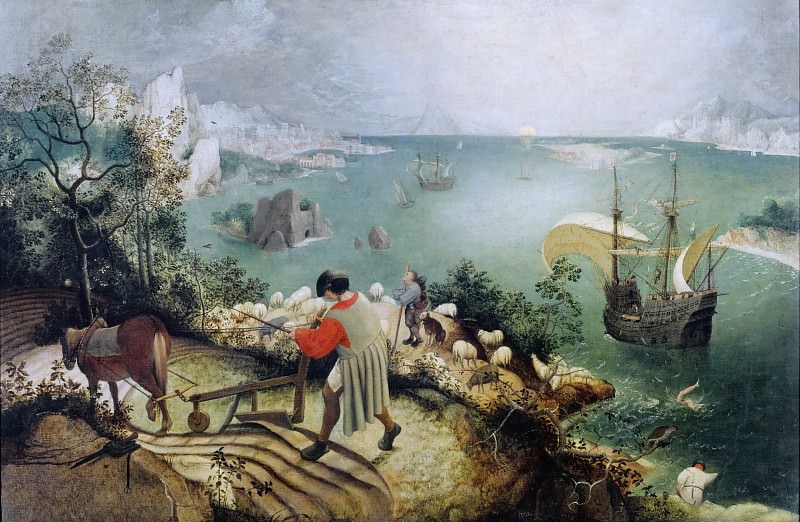The fall of Icarus Pieter Brueghel The Elder (1525-1569)
Pieter Brueghel The Elder – The fall of Icarus
Edit attribution
Download full size: 4420×2884 px (5,4 Mb)
Painter: Pieter Brueghel The Elder
Location: Royal Museum of Fine Arts (Koninklijke Musea voor Schone Kunsten), Brussels.
The mythological background of the painting is known to almost everyone. The author portrayed the ending of this story in a very specific way. In the foreground, one can see the characters that are quite irrelevant to the main idea of the painting. However, this plowman, who is engaged in his work and does not even pay attention to what is happening, symbolizes the indifference to the fallen Icarus. The main face of this myth can be seen in the center of the painting, but even here it is worth making an effort to discern his legs, comically sticking out of the water surface.
Description of Peter Brueghel’s painting The Fall of Icarus
The mythological background of the painting is known to almost everyone. The author portrayed the ending of this story in a very specific way.
In the foreground, one can see the characters that are quite irrelevant to the main idea of the painting. However, this plowman, who is engaged in his work and does not even pay attention to what is happening, symbolizes the indifference to the fallen Icarus.
The main face of this myth can be seen in the center of the painting, but even here it is worth making an effort to discern his legs, comically sticking out of the water surface. The river is covered in feathers from the broken wings of the hapless Icarus.
Icarus’ father cannot be seen in the painting. However, we can assume that the grief-stricken father flew away from the spot when he noticed the shepherd’s gaze. Icarus crashed into the water surface unnoticed by the common people - no one noticed him. They all go on about their earthly business.
But there is only one being in the picture who cares about Icarus’ fall. The gray partridge, perched on a rocky cliff, is watching him intently. There is a legend associated with this creature, which says that Daedalus killed his nephew after he realized that he was showing far greater ability than the master himself. Envy and the threat of oblivion blinded the master and Daedalus killed the boy. But Perdix did not die falling from the rocks. Merciful Athena took pity on the boy, and he turned into a grey partridge. The little bird gloats, watching the situation: Daedalus’ sin has returned to him. Perdix is avenged.
The entire action of the painting develops against the background of a picturesque landscape painted in the traditions of Dutch painting. The entire painting, however, is painted in calm, low-bright tones. The entire background beyond the horizon is occupied by the sun. It is the sun that caused Icarus to fall. But the sun is not the bright spot of the landscape: however, the whole picture appears to the eye in a haze of dim sunlight.
Кому понравилось
Пожалуйста, подождите
На эту операцию может потребоваться несколько секунд.
Информация появится в новом окне,
если открытие новых окон не запрещено в настройках вашего браузера.
You need to login
Для работы с коллекциями – пожалуйста, войдите в аккаунт (open in new window).




















COMMENTS: 1 Ответы
Благодарю.
You cannot comment Why?
The expansive sea is dotted with various ships, from majestic galleons to smaller sailing vessels, suggesting a bustling port or a significant trade route. In the middle distance, a fortified island and remnants of ancient structures hint at a rich historical past. Further out, a city sprawls along the coastline, nestled against a mountainous backdrop.
However, the titular event, the fall of Icarus, is remarkably understated. Barely visible in the lower right corner of the vast sea, are two small legs flailing from the water, the only indication of Icaruss tragic demise. A fisherman in a small boat continues his fishing, unperturbed, casting his line near the splashing limbs, and a dark bird flies overhead.
The subtext of this painting is profound. It speaks to the indifference of the world to individual tragedy, especially for those outside the realm of power or fame. While Icaruss ambition led to his downfall, the vast majority of humanity remains occupied with their everyday lives, their labor, and their pursuits, rarely acknowledging or being affected by the dramatic events that do not directly impact them. The painting emphasizes the continuity of life and the mundane tasks that persist regardless of extraordinary occurrences. It can be interpreted as a commentary on human nature, where the ordinary often eclipses the extraordinary, and where the pursuit of personal aspirations, like Icaruss flight, can go unnoticed by the world at large.